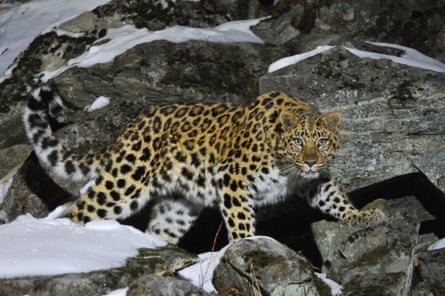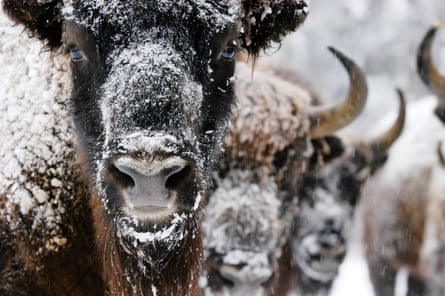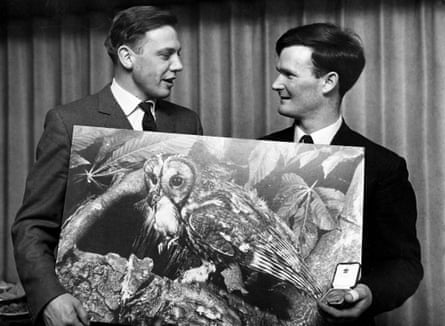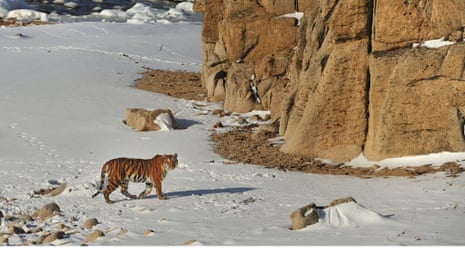Toshiji Fukuda went to extraordinary lengths to photograph an Amur tiger, one of the world’s rarest mammals, in 2011. He built a tiny wooden hut overlooking a beach in Russia’s remote Lazovsky nature reserve, on the Sea of Japan, and spent the winter there. Fukuda was 63 at the time. “Older people have one advantage: time passes more quickly for us than the young,” he said later.
Possession of such resilience was fortunate because Fukuda had to wait seven weeks for his only glimpse of an Amur tiger, which resulted in a single stunning image of the animal strolling imperiously along the beach below his hide. “It was as if the goddess of the Taiga had appeared before me,” he recalled.

In recognition of the photographer’s efforts, Fukuda was given a key award at the 2013 Wildlife Photographer of the Year exhibition, an annual event that has showcased the best images taken of the planet’s rarest animals and habitats and which has taken on an increasingly important role in recording their fates. This year’s exhibition, which opens on Friday, is the 50th such exhibition – to be held, as usual, at the Natural History Museum – and a recent study of past winning images has revealed the unexpected twists of fortune that have affected the world’s wildlife.
Some animals, which appeared to be doing well, have plummeted towards extinction. Others, which seemed to be doomed, have bounced back. “It still seems to be very much a matter of hit or miss whether a threatened species recovers or instead continues to dwindle towards extinction,” said the museum’s curator of mammals, Roberto Portela Miguez.

A classic example is provided by the Amur tiger (sometimes known as a Siberian tiger). In the 1940s, there were no more than 40 left in the wild. Today, there are around 400, although it is still considered to be an endangered species. However, this modest recovery contrasts with the fate of the Amur tiger’s cousin species, the Amur leopard. In 1960, there were about 1,500 Amur leopards left in the wild. Today there are around 35. In the case of the Amur tiger, schemes to expand reserves and ban hunting have helped to stabilise numbers. However, these efforts have failed to save the Amur leopard, though it is not clear why.
A similar twist in fates has been observed for the Ibex. The Alpine sub-species of this goat-like creature had slumped to around 9,000 in 1965. Conservation efforts to restrict hunting have since seen numbers bounce back to around 32,000. However, these measures were introduced too late to save its cousin, the Pyrenean Ibex, which was declared extinct in 2000.
Then there is the Pyrenean chamois – another goatlike creature. Its numbers were dwindling 50 years but have since increased to around 25,000. However, numbers of its Italian cousin, the Abruzzo chamois, have dwindled.

“It is quite clear that species we thought would never be really in trouble have found themselves suddenly plunging towards extinction while others have bounced back against expectation,” said Rosamund Kidman Cox, who has played a key role in organising the wildlife exhibition for 30 years. “If you had said to wildlife photographers 50 years ago that the rhino would be poached to near extinction in only a few decades, they would not have believed you. But the lure of rhino horn has proved too much over the years and it is endangered in all its remaining habitats.”
In contrast, the bison – which was almost wiped out in Europe – has now recovered, thanks to reintroduction programmes, with populations reaching 9,000. “The crucial point is that we record these animals while we have them and let people know what is going on,” she added.
This point was backed by David Attenborough, who presented the awards at the first Wildlife Photographer of the Year exhibition in 1955. “If people do not know about an animal and about the problems that it faces, it is obvious they will not be going to do much about it. By bringing our attention to the plight of endangered species, these photographers are doing a great service to the world’s wildlife,” said Attenborough who will return, five decades on, to give out prizes at this year’s exhibition.

Such work is encouraging, though experts warn that even if some species are recovering from past adversity, the overall trajectory for the world’s wildlife is grim, a point stressed by the WWF last month when it revealed that over the past 40 years, there had been a 48% slump in numbers of wild animals.
Wildlife Photographer of the Year runs from 24 October to 30 August 2015 at the Natural History Museum, London. Tickets at nhm.ac.uk/wpy








Comments (…)
Sign in or create your Guardian account to join the discussion